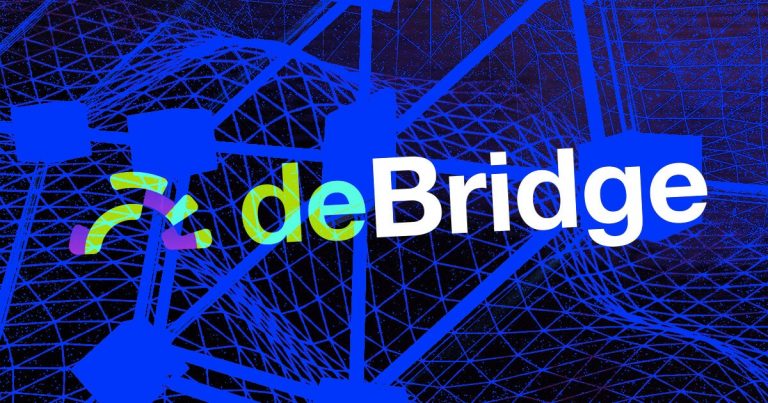
deBridge has integrated support for HyperEVM, enabling seamless cross-chain and same-chain asset transfers to Hyperliquid’s high-performance Layer 1 blockchain. This allows users to trade any token on HyperEVM, including native $HYPE, across supported chains like Ethereum and Arbitrum with minimal friction. deBridge’s support for HyperEVM enables fast, secure, and low-cost transfers of assets between HyperEVM and other major blockchains like Ethereum, Solana, Arbitrum, and more.
This is facilitated by deBridge’s dePort solution, which ensures 1:1 collateral backing for tokens, minimizing risks associated with traditional bridging methods like liquidity pools. By connecting HyperEVM to a wide range of EVM and non-EVM chains, deBridge allows users and developers to tap into Hyperliquid’s high-performance Layer 1 blockchain without being restricted to a single ecosystem.
This fosters a more interconnected DeFi landscape, enabling users to move assets like USDC or $HYPE to HyperEVM for trading or dApp interactions. Developers can now build cross-chain applications that leverage HyperEVM’s high-throughput environment and Hyperliquid’s deep liquidity. This opens up opportunities for innovative DeFi protocols, NFT platforms, and AI-driven financial applications, as HyperEVM supports Ethereum-compatible smart contracts.
Register for Tekedia Mini-MBA edition 19 (Feb 9 – May 2, 2026): big discounts for early bird.
Tekedia AI in Business Masterclass opens registrations.
Join Tekedia Capital Syndicate and co-invest in great global startups.
Register for Tekedia AI Lab: From Technical Design to Deployment (next edition begins Jan 24 2026).
HyperEVM’s integration with deBridge channels liquidity from other chains into Hyperliquid’s ecosystem, enhancing its role as a leading decentralized exchange (DEX) for perpetual futures and spot trading. With Hyperliquid already capturing significant on-chain trading volume (e.g., $14.58B in 24-hour volume), this move could further solidify its market position. HyperEVM’s seamless integration with HyperCore (Hyperliquid’s trading engine).
This unified state design allows tokens like $HYPE to move effortlessly between HyperCore and HyperEVM, enhancing user experience and developer efficiency. The HyperEVM ecosystem’s growth, supported by deBridge, may increase opportunities for airdrops and community rewards. With 38.88% of $HYPE’s supply reserved for future releases, users bridging assets to HyperEVM could benefit from potential incentives, driving further adoption.
HyperEVM’s dual-block architecture (small blocks for fast transactions and large blocks for compute-intensive tasks) combined with deBridge’s low-latency bridging enables sub-second transaction finality and high throughput (up to 200,000 orders per second). This makes HyperEVM a compelling choice for high-frequency trading and real-time DeFi applications. Hyperliquid’s gasless trading on HyperCore and low gas fees on HyperEVM (using $HYPE as the gas token) reduce barriers for users.
deBridge’s Lock-and-Mint mechanism ensures secure asset transfers by maintaining a 1:1 ratio between locked assets on the source chain and minted assets on HyperEVM. Its decentralized validator network and slashing mechanics further enhance security, reducing risks associated with bridge exploits, which have caused over $2.8B in losses historically. Hyperliquid’s unified state design and deBridge’s trustless protocol minimize reliance on centralized bridges, addressing a key pain point in DeFi where third-party intermediaries have been vulnerable to hacks.
The integration of HyperEVM support by deBridge also underscores the persistent divide between blockchain ecosystems, which can be categorized by technical architecture, ecosystem priorities, and user experience. This divide is both a challenge and an opportunity, and deBridge’s role in bridging these gaps highlights the following tensions. Many blockchains, like Solana or Hyperliquid, operate outside the Ethereum Virtual Machine (EVM) standard, creating silos that hinder interoperability.
HyperEVM bridges this gap by offering EVM compatibility within Hyperliquid’s high-performance Layer 1, but its unique HIP-1 and HIP-2 token standards (distinct from ERC-20) create a learning curve for developers migrating from Ethereum-based ecosystems. deBridge’s support for both EVM and non-EVM chains (e.g., Solana to HyperEVM) mitigates this divide but doesn’t fully eliminate it due to differing consensus mechanisms and programming models.
Ethereum’s Layer 2 solutions (e.g., Arbitrum, Optimism) prioritize scalability but often face fragmentation when interacting with high-performance Layer 1 blockchains like Hyperliquid. deBridge’s ability to bridge assets from Layer 2s to HyperEVM reduces friction, but the cost disparity (e.g., $5–$10 on Ethereum mainnet vs. under $1 on Base) highlights the ongoing divide in scalability and cost efficiency.
Hyperliquid’s focus on high-frequency trading and derivatives (via HyperCore) contrasts with general-purpose blockchains like Ethereum, which prioritize broad dApp ecosystems. HyperEVM’s integration with deBridge allows it to tap into Ethereum’s DeFi ecosystem (e.g., Aave, Uniswap) while maintaining its trading-centric architecture, but this creates a divide between trading-optimized platforms and those focused on diverse applications like NFTs or GameFi.
Hyperliquid’s on-chain order book and gasless trading mimic centralized exchange (CEX) performance, challenging platforms like Binance. However, its closed-source components and limited validator count raise decentralization concerns, creating a divide between fully decentralized ecosystems (e.g., Ethereum) and performance-driven platforms like Hyperliquid. deBridge’s decentralized validator network helps bridge this gap by ensuring trustless transfers, but the divide persists in governance and transparency.
Bridging assets across chains remains complex for non-technical users, despite deBridge’s user-friendly interface. HyperEVM’s integration simplifies access to Hyperliquid’s ecosystem, but users must navigate wallet setups, network configurations (e.g., adding HyperEVM to MetaMask), and bridge fees, which vary by source chain. This contrasts with CEXs, where users face fewer technical barriers but sacrifice self-custody.
Liquidity fragmentation across blockchains remains a challenge. While deBridge’s Lock-and-Mint mechanism ensures secure transfers, the need to bridge assets to HyperEVM to access its liquidity highlights the divide between ecosystems with deep liquidity (e.g., Ethereum) and emerging platforms like Hyperliquid. Hyperliquid’s 67% share of Arbitrum’s USDC supply underscores its growing liquidity, but it still competes with established ecosystems.
While deBridge’s integration with HyperEVM is a step toward unifying blockchain ecosystems, it also exposes the persistent fragmentation in the blockchain space. The reliance on bridges like deBridge highlights the lack of native interoperability between chains, as each operates with distinct consensus mechanisms, token standards, and priorities.
This creates a fragmented user experience, where users must navigate multiple platforms, wallets, and fees to access different ecosystems. Moreover, Hyperliquid’s closed-source components and focus on trading performance raise questions about its long-term decentralization, a core tenet of blockchain ideology. The divide between performance-driven platforms (e.g., Hyperliquid, Solana) and decentralization-focused ecosystems.



